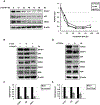DCAF7 is required for maintaining the cellular levels of ERCC1-XPF and nucleotide excision repair
- PMID: 31493872
- PMCID: PMC6759389
- DOI: 10.1016/j.bbrc.2019.08.147
DCAF7 is required for maintaining the cellular levels of ERCC1-XPF and nucleotide excision repair
Abstract
The ERCC1-XPF heterodimer is a structure-specific endonuclease and plays multiple roles in various DNA repair pathways including nucleotide excision repair and also telomere maintenance. The dimer formation, which is mediated by their C-terminal helix-hairpin-helix regions, is essential for their endonuclease activity as well as the stability of each protein. However, the detailed mechanism of how a cellular level of ERCC1-XPF is regulated still remains elusive. Here, we report the identification of DDB1- and CUL4-associated factor 7 (DCAF7, also known as WDR68/HAN11) as a novel interacting protein of ERCC1-XPF by mass spectrometry after tandem purification. Immunoprecipitation experiments confirmed their interaction and suggested dominant association of DCAF7 with XPF but not ERCC1. Interestingly, siRNA-mediated knockdown of DCAF7, but not DDB1, attenuated the cellular level of ERCC1-XPF, which is partly dependent on proteasome. The depletion of TCP1α, one of components of the molecular chaperon TRiC/CCT known to interact with DCAF7 and promote its folding, also reduced ERCC1-XPF level. Finally, we show that the depletion of DCAF7 causes inefficient repair of UV-induced (6-4) photoproducts, which can be rescued by ectopic overexpression of XPF or ERCC1-XPF. Altogether, our results strongly suggest that DCAF7 is a novel regulator of ERCC1-XPF protein level and cellular nucleotide excision repair activity.
Keywords: DCAF7/WDR68/HAN11; ERCC1-XPF; Nucleotide excision repair; TRiC/CCT.
Copyright © 2019 Elsevier Inc. All rights reserved.
Figures




Similar articles
-
CARM1/PRMT4 facilitates XPF-ERCC1 heterodimer assembly and maintains nucleotide excision repair activity.Nucleic Acids Res. 2025 Apr 22;53(8):gkaf355. doi: 10.1093/nar/gkaf355. Nucleic Acids Res. 2025. PMID: 40304182 Free PMC article.
-
Mapping of the regions implicated in nuclear localization of multi-functional DNA repair endonuclease XPF-ERCC1.Genes Cells. 2022 May;27(5):356-367. doi: 10.1111/gtc.12932. Epub 2022 Mar 8. Genes Cells. 2022. PMID: 35238109
-
Inhibition of the ERCC1-XPF structure-specific endonuclease to overcome cancer chemoresistance.DNA Repair (Amst). 2015 Jul;31:19-28. doi: 10.1016/j.dnarep.2015.04.002. Epub 2015 Apr 22. DNA Repair (Amst). 2015. PMID: 25956741
-
Function and Interactions of ERCC1-XPF in DNA Damage Response.Molecules. 2018 Dec 5;23(12):3205. doi: 10.3390/molecules23123205. Molecules. 2018. PMID: 30563071 Free PMC article. Review.
-
The ERCC1 and ERCC4 (XPF) genes and gene products.Gene. 2015 Sep 15;569(2):153-61. doi: 10.1016/j.gene.2015.06.026. Epub 2015 Jun 12. Gene. 2015. PMID: 26074087 Free PMC article. Review.
Cited by
-
Advances in molecular characterization of myeloid proliferations associated with Down syndrome.Front Genet. 2022 Aug 10;13:891214. doi: 10.3389/fgene.2022.891214. eCollection 2022. Front Genet. 2022. PMID: 36035173 Free PMC article. Review.
-
Insights from the protein interaction Universe of the multifunctional "Goldilocks" kinase DYRK1A.Front Cell Dev Biol. 2023 Oct 12;11:1277537. doi: 10.3389/fcell.2023.1277537. eCollection 2023. Front Cell Dev Biol. 2023. PMID: 37900285 Free PMC article. Review.
-
CARM1/PRMT4 facilitates XPF-ERCC1 heterodimer assembly and maintains nucleotide excision repair activity.Nucleic Acids Res. 2025 Apr 22;53(8):gkaf355. doi: 10.1093/nar/gkaf355. Nucleic Acids Res. 2025. PMID: 40304182 Free PMC article.
-
Restriction of influenza A virus replication by host DCAF7-CRL4B axis.J Virol. 2025 Apr 15;99(4):e0013325. doi: 10.1128/jvi.00133-25. Epub 2025 Mar 27. J Virol. 2025. PMID: 40145735 Free PMC article.
-
DCAF7 regulates cell proliferation through IRS1-FOXO1 signaling.iScience. 2022 Sep 24;25(10):105188. doi: 10.1016/j.isci.2022.105188. eCollection 2022 Oct 21. iScience. 2022. PMID: 36248734 Free PMC article.
References
-
- Matsunaga T, Park CH, Bessho T, et al., Replication protein A confers structure-specific endonuclease activities to the XPF-ERCC1 and XPG subunits of human DNA repair excision nuclease, J. Biol. Chem 271 (1996) 11047–11050. - PubMed
-
- Sijbers AM, de Laat WL, Ariza RR, et al., Xeroderma pigmentosum group F caused by a defect in a structure-specific DNA repair endonuclease, Cell 86 (1996) 811–822. - PubMed
Publication types
MeSH terms
Substances
Grants and funding
LinkOut - more resources
Full Text Sources
Research Materials

